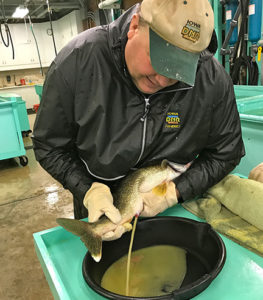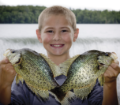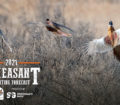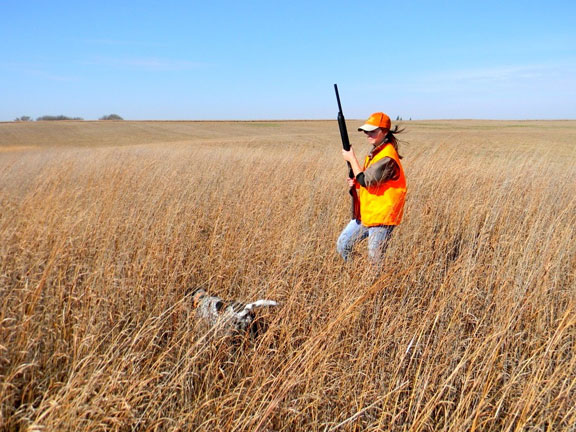
(photo by Steve Weisman) A DNR worker strips eggs from one of the female walleyes from the final night of seining .
By Steve Weisman
This is always an exciting, anxious time for DNR biologists and technicians at the Spirit Lake Hatchery. It is netting season, and based on Mother Nature, it can be a short, yet intense time, or it can be a long drawn out period of time.
Last spring (2016) was a marathon and took nearly 14 days to complete the egg collection process. Warm weather, cool weather ups and downs and lots of wind made the entire process a struggle.
This spring (2017), however, was much different. Test netting began on Monday, April 3 with crews collecting 44 walleyes from East Okoboji. Things picked up the next night with148 walleyes.
Then the crews headed to Big Spirit and the netting efforts were outstanding:
April 5 – 232 males and 103 females; April 6 – 420 males and 143 females; April 7 – 180 males and 153 females; April 8 – 124 males 158 females. That’s 1533 walleyes in FOUR nights. The normal date for gill netting is around April 6 with the right photo period and water temperature in the mid-40s. Well, this past Thursday, April 6 was THE night! Awesome!
The final two nights found them on West Okoboji with a combined 416 walleyes taken combined over those two nights. The total number of broodstock brought into the hatchery was 2781 walleyes.
It appears that around 1000 quarts of eggs will be collected. This equates to 135,000 fry per quart with a successful hatch rate at 70 percent per quart. That means approximately 94,500 fry per quart. I’d call that quite a haul!
When I stopped in this past Wednesday (April 12), the crew was finishing the last day of stripping eggs. These females had come from the lone night of seining on West Okoboji. Spirit Lake Fish Hatchery Biologist, Kim Hawkins was definitely pleased with the way the netting process has gone this year. At the same time, I could tell that all of the workers, though happy with the results, were tired from the long and intense hours. As I watched the workers handle the fish and strip the eggs, I knew there was no way my old back, arms and hands would be able to handle that type of work anymore!
Earlier this spring, 293 northern pike were collected that will mean 1.62 million hatched pike, while 108 muskies were collected. The largest muskie was a 46.5 pounder taken from Big Spirit.
After the spawning process is completed and the adult fish have recuperated, they are then returned to the lakes from which they were netted. There may still be some fish in the tanks yet this week. However, with the spawning completed, hours will return to the normal weekday hours.
If you want to learn more about the entire netting process, a video is being played in the lobby showing and discussing each step. There is no doubt without the help of the egg collection process, we would not have the quality walleye, northern and muskie fishing in our Iowa lakes and rivers.
I actually visited the hatchery three different times, once by myself, once with my wife and once with my six-year-old granddaughter. Talk about quality fish! Trophy muskies that looked like huge logs in the water and a whole bunch of incredibly fat slot walleyes (17-22 inchers) and a lot of walleyes in the mid-20s and larger!
Yes, I think Iowa’s hatcheries are doing a great job raising and stocking our lakes! They definitely deserve a tip of the hat!
















